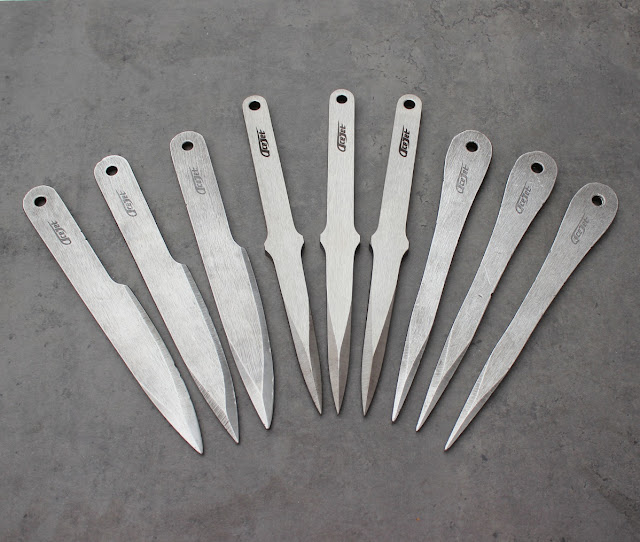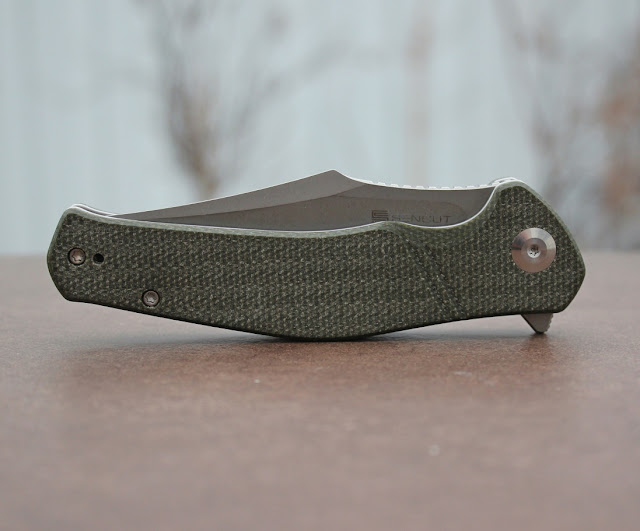...they say. In this case, it's not about life or death, unless I'm too close to a rebound from the target that is. The closest I came was a small stab wound in the stomach and some blood running from a leg from time to time.
Today's subject is knife throwing and a summary of, my throwing season 2021. This was the year when I started training.
Knife throwing is something I have always been interested in but which is now very close to my heart. A large part of it can be attributed to the Internet. With the information, the ideas I received, and the people I "met" online, I have given myself an enormous amount of knowledge and insight that I did not have before. At early dawn, that is, since childhood / early teens, a lot of knives were thrown in the forests north of lake Helgasjön, south Sweden, where I grew up.
In the beginning, there were many throwing knives from Germany bought via paper catalogs. A typical generational issue. You who know what I'm talking about are probably smiling a little to yourself right now. The rest of you are probably most puzzled. The word for the day at that time was "Wurfmesser" and they were called things like "Silver Arrow" or rather "Silberpfeil Original" and "Pro" and were made in Solingen. They all broke eventually and with today's standards they were not much to talk about. Often with rat tail tangs with stacked leather handles and threaded pommels. The result of that construction was that they inevitably broke in the vicinity of the transition between blade and handle.
But even the knives in solid steel that were obtained broke sooner or later, usually sooner. Later, for various reasons, it was worn out professional knives from the Bahco brand knives that were used as throwing projectiles along with second-hand, damaged chisels. The favorite knife then became a copy of a Gerber Mark I. A knife that I actually still have.
Now I have other knives at my disposal. Knives that had made my younger self become green with envy. Most of them are basically impossible to destroy. Or well, I make really good attempts from time to time. As you can see in the pictures, all knives have many scars and rounded points. A result of many "Robin Hood hits".
 |
| Wulflund Vengeance, knives in 8 mm thick spring steel. They are extremely difficult to break |
But in addition to theoretical knowledge, you need practical experience. So in addition to reading and improving myself in most things that can be found online, there has been a lot of throwing and a number of knives have been acquired. It is partly needed for the different disciplines I try to engage in and partly it gives the experience of how different projectiles behave. In other words, I do the opposite of what most people recommend. I have not specialized in one thing and then broadened my horizons from there. I throw everything that is not attached to something, including stone in glass houses and with any technique.
My basis is "Military half-spin" as it was the only technique I knew of back then. It means that the thrower holds the knife by the blade and controls the throw with a thumb on the side of the blade. A technique that can be used to throw anything including knives with an edge, a tent pole, a screwdriver, or a fork. But it is best done with throwing knives that are a bit handle-heavy. Various Arrow-inspired knives are excellent such as Wulflund Vengeance and Acejet Stinger. Osetr-variants like Biting Metal Bug Osetr TZ and AceJet Apache are also very good even though they are even better at another technique.
 |
| My knives from AceJet so far: The models are called Apache, Excalibur, and Stinger |
I'm, of course, referring to "No spin", ie techniques where you grip the knife by the handle and throw it without rotation or more correctly about a quarter of a turn from the time it's released until it is hopefully found in the target. The same applies here, everything can be thrown with those techniques (there are a few different schools, including Skanff for example) but it is easier with knives that are more or less handle-heavy. Especially if you are a beginner.
 |
| The bottom knives, T1XL from Polish Graf Knives were my first really good set of throwing knives. Top, the model T2 Bowie from the same brand |
But times are changing and in May I was determined to learn rotational throwing. Something I have never mastered before. For that purpose, a couple of sets of knives were also procured. It all certainly started with Spyderco's Large Spyderthrowers which were already in the knife collection along with an old United Cutlery knife. But those knives have some real shortcomings. Then there were Graf Knives models T1XL and later T2 Bowie, along with Condor Dismissal and finally the wonderful Woodpecker from Pierre Cazoulat.
 |
| Knives that are excellent for No spin, although the Bug Osetr TZ on the right is also excellent for rotational throwing. They come from French Biting Metal. To the left is the AceJet Stinger |
It can be said that I'm rapidly improving. It is also this technique and in the discipline "walk back" I train most alongside No-spin. Given the dimensions of my garden, there has been a lot of precision throwing at short distances (three and four meters) in recent months. I have to go out into the woods for the longer distances needed for both "walk back" and long-distance throwing. It must therefore wait until spring.
 |
| These French knives from Pierre Cazoulat called Woodpecker are extremely good for rotational throwing and are specificaally developed for the "Walk Back" discipline. |
For that reason, I'm a little unsure how many throws there will be this year, after all, there are a few weeks left. But from what it seems, it can in principle be summed up now. It is not so difficult in my case as I'm a keen bike rider and from there I am used to training diaries. A habit I took with me to the throwing world.
Therefore, I have statistics on most things even if they are not complete. I only started after I bought my first set of AceJet knives. Before that, I threw with the knives I had from Hibben, UC, Max Knives, and Spyderco.
With that said, the first interesting figure is the total number that ends up just over 175,000 throws.*
Of these, the Graf T1XL model accounts for as many as 59,000. The reason is that they were the first real set I got. By the way, I have not even had time to inaugurate the latest knives, AceJet Excalibur! In September, it was apparently good weather because then more than 28,000 throws were recorded for 69 hours, which is a record so far. The total time I spent throwing knives this season is about 375 hours.
These are numbers that I am fully convinced will go up in smoke next year. When I decide on something, I usually get pretty good at it. And now I set my mind on getting better, especially on no-spin but also rotational throwing with a focus on fixed competition distances such as three and five meters and Walk back in both disciplines. In addition, I intend to immerse myself in backhand throwing, underhand throwing, and other fun variations. There is so much to learn!
Then there will hopefully be a Swedish Championship and a World Championship next year if not for pandemics and other shit. I intend to show up if possible, rest assured!
J - your digital knife thrower
* And since I wrote this text a few days ago, the snow melted and I added another 4000 throws and ten hours on top of that.




















